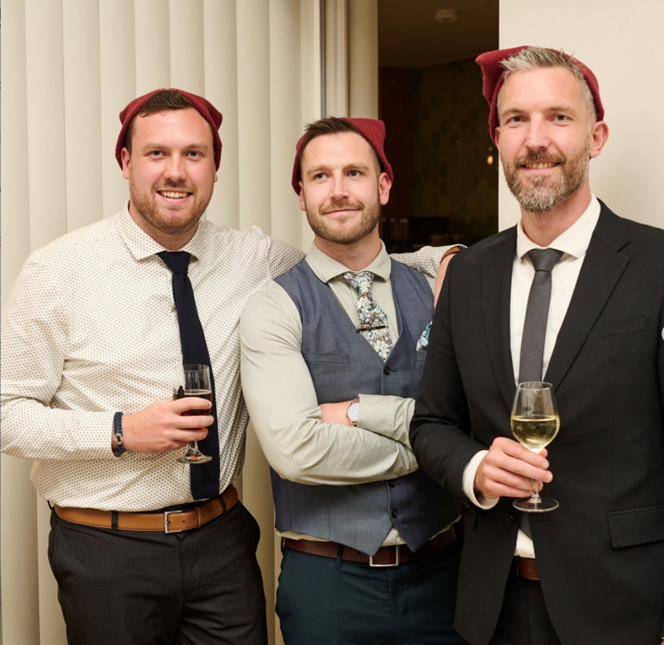
If we told you that three brothers whose names all started with “M” wore matching red caps and came from a far away land to spread the spirit of togetherness, you might think this was a fairytale.
But Danish brothers Mads, Martin and Mathias Klarborg are real, and they’re traveling from Philadelphia down to Baltimore and Washington D.C. this week, April 10 to April 12, spreading the word about the Klarborg elves and sprinkling the Hygge spirit all the way.
Klarborg, a Danish design brand, was founded in 1986 by Etly Klarborg. Etly Klarborg had her first son, Martin, that same year. Inspired by the stories her mother brought to life and her loved ones, Etly began creating the Klarborg elf family. Today, the Klarborg brand is best known for its keepsake elf figurines.
We spoke to the three brothers to learn more about the Danish concept of hygge (hoo-gah or heu-gah), the Klarborg elves and and what American families can learn from the Danish lifestyle.
What is hygge?
It’s like mindfulness, before mindfulness was a thing. It’s actively choosing to be present with your children or your family, so if we had a stressful day we can choose to hygge. We don’t think about a lot of other things. It’s like, now we are making hygge, we are talking, we are having a good time. You don’t think about what we did at work or what went wrong at work or “I have to go to the dentist tomorrow.” It’s more like, here and now.
Why is hygge important?
It’s really important to have here because, for us, it’s like a stressless thing, so you calm down, you set your mindset to “We need to be relaxed, we need to be calm.”
It’s like mindfulness in a way, and it’s when you create memories with your family. Because, when you have a lot on your mind and time is just passing or when you have all these responsibilities, sometimes you just stop and you realize it’s been three months since I saw my best friend because now life is just moving.
It’s especially important for your children. That’s when they really can connect to their parents I think, because when you focus and you have time to actually look at this drawing that might not be very good…you have time with your children, you know they are going to appreciate this time, and that’s one of the things that makes it very important. Do not overthink it.
It’s also really important to your mental health to do the things you would like to do instead of doing what you’re supposed to do from other people’s opinions.
How can families create these intentional moments and spaces?
We had a discussion on [our] podcast where we realized that hygge is somewhat adopted by the U.S., or at least, a lot of people know about hygge, but their understanding was that you had to go buy a couch, so it’s very commercialized here. We’d like to maybe correct that a little bit. Like we said, it’s like mindfulness, and it’s a very intentional thing that you can choose to do. It’s a mindset.
What you have to do to get into the mode is to look around, and look at your children, and look at your partner, and say “We should do something together right now. Should we get popcorn or hot chocolate?” It’s something you choose then right now. You don’t have to buy a lot of things, you don’t need exactly this device to do it. It’s something you do, you find it out, find it together.
What are some of the differences you’ve noticed between the American lifestyle and the Danish lifestyle?
We definitely notice a difference in our mentality of ‘less is more’ where here (in the U.S.), more is more. So, that’s a big difference, and I think that’s also why our Danish design is very popular here because it’s different than what you’re used to.
We can definitely tell when we’re driving around—everything is huge. You have huge trucks. That’s a big difference. In Denmark, it’s different. It’s more simple, smaller in a way.
When you put your home together (in Denmark) with all the other minimalistic things, it’s a calm setting. I’m sure some Americans would find it boring because there’s not a lot going on, but I think it comes down to—we’re very intentional with our interiors, and we’re very intentional in making these hygge spots. So, if there’s a blanket on the couch, it’s very intentional, and it’s there to be used.
And finally, why do the elves help with the Christmas spirit? What is their agenda?
You know, Santa’s sleigh has to have an amount of Christmas spirit in order to fly, so in your mythology, it’s something that’s on the people to create Christmas spirit. In Denmark, it’s like, we need a little help. In stressful everyday life, these elves make sure that you know that now it’s December, you have to start. It’s like mindfulness.







